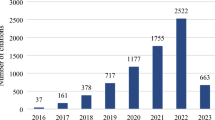Abstract
Minimum Spanning Tree (MST) algorithm developed by Modak and Lohani (1984a) has been extended to consider multiple objectives for the optimum siting of ambient air monitors. Two approaches have been proposed, namely one based on the utility function and another based on the principles of sequential interactive compromise. The sequential interactive approach is heuristic but perhaps best suited to consider several objectives at a time, and particularly when professional judgements are also involved. The utility function approach may be normally restricted to two objectives at a time, but could be extended to consider a number of pollutants in the optimum design. For the purpose of illustration, the case of Taipei City, Taiwan has been considered.
Similar content being viewed by others
References
Cohon, J. L. and Marks, D. H.: 1975, ‘A Review and Evaluation of Multi-objective Programming Techniques’, Water Resources Research II, 208–220.
Godfrey, S. M., Novak, J. H., and Turner, D. B.: 1975, ‘A Modelling Study to Examine Detection of Violations of Air Quality Standards Using Various Sampling Station Networks in the Vicinity of a Single Plant’, Report 76-23.3, Pittsburgh; Air Pollution Control Association.
Hwang, C. L., Paidy, S. R., Yoon, K. and Masud, A. S. M.: 1980, ‘Mathematical Programming with Multiple Objectives: A Tutorial’, Computers and Operations Research 7, 5–31.
Jain, R. K., Urban, L. V., and Stacey, G. S.: 1977, Environmental Impact Analysis: A New Dimension in Decision Making, Van Nostrand Reihold, New York, U.S.A., Appendix B, pp. 178–209.
Modak, P. M.: 1984, ‘Optimum Siting of Ambient Air Monitors’, A Dissertation submitted as the partial fulfillment for a degree of Doctor of Engineering, Asian Institute of Technology, Bangkok, Thailand.
Modak, P. M. and Lohani, B. N.: 1984a, ‘Optimization of Ambient Air Quality Monitoring Networks — Part I’, Environmental Monitoring and Assessment 5, 1–19.
Modak, P. M. and Lohani, B. N.: 1984c, ‘Optimization of Ambient Air Quality Monitoring Networks — Part III’, Environmental Monitoring and Assessment 5, 39–53.
Munn, R. E.: 1981, Design of Air Quality Monitoring Networks, Macmillan Press Ltd, Basingstoke, Hampshire, U. K.
Naito, M. and Ochiai, M.: 1981, ‘On Optimal Allocation of Air Monitoring Stations’, International Seminar on Air Quality Management and Related Energy Policies, Tokyo, Japan, pp. 247–265.
Ott, W. R.: 1978, Environmental Indices: Theory and Practice, Ann Arbour Science.
Smith, D. G. and Egan, B. A.: 1979, ‘Design of Monitoring Networks to Meet Multiple Criteria’, Journal of Air Pollution Control Association 29, 710–714.
Taipei City Summary of Statistics: 1981, Taipei, Taiwan.
World Health Organization (WHO): 1977, ‘Air Monitoring Programme Design for Urban and Industrial Areas’, Global Environmental Monitoring System, WHO Offset Publication No. 38.
Zeleny, M.: 1982, Multiple Criteria Decision Making, McGraw Hill, New York.
Author information
Authors and Affiliations
Rights and permissions
About this article
Cite this article
Modak, P.M., Lohani, B.N. Optimization of ambient air quality monitoring networks. Environ Monit Assess 5, 21–38 (1985). https://doi.org/10.1007/BF00396392
Received:
Issue Date:
DOI: https://doi.org/10.1007/BF00396392




